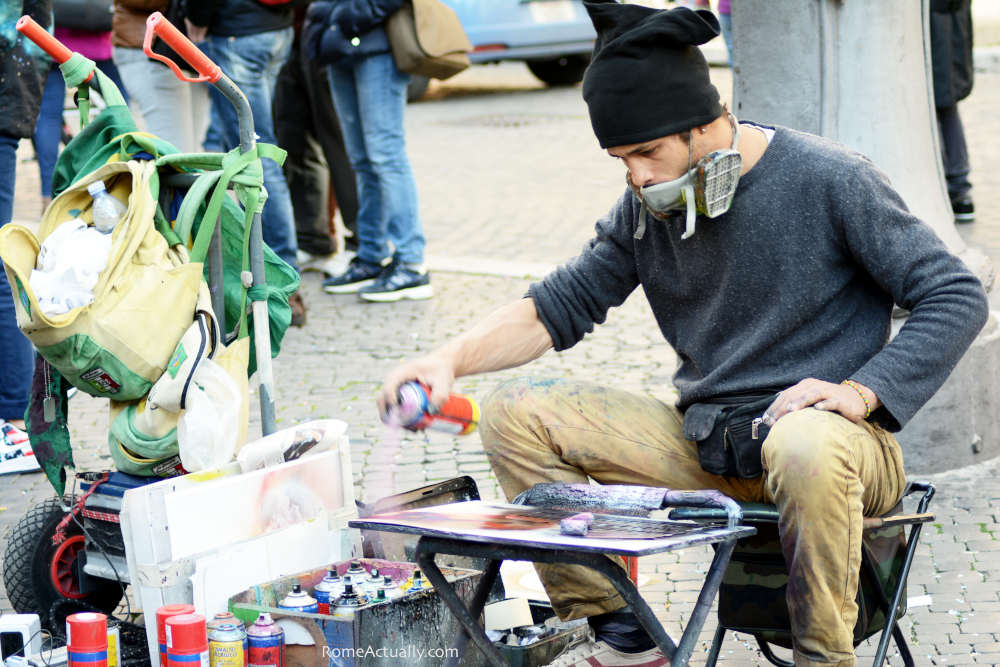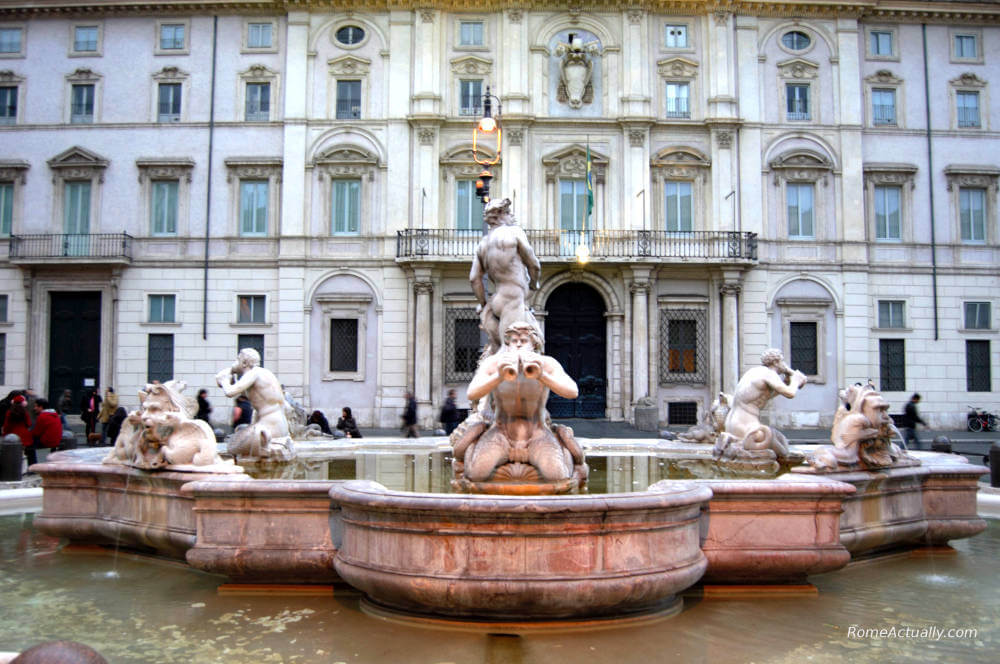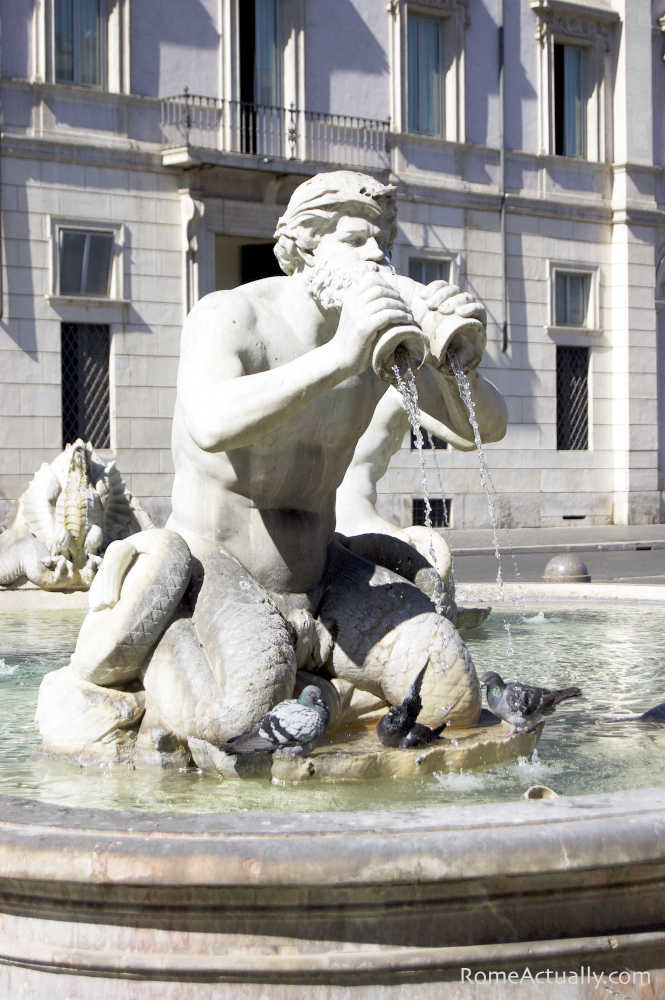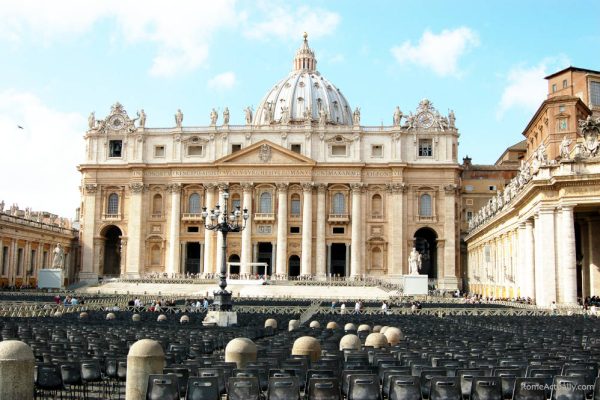Arguably one of the most exclusive and expensive areas to stay in Rome, learning about some little-known Piazza Navona facts is an exciting start to knowing more about one of the most desirable neighborhoods in the city center. The location is pretty hard to beat: easy to reach and close to many important landmarks, this is also one of Rome’s most beautiful piazzas.
If it’s your first trip, you will certainly include it on your Rome bucket list. If it’s not your first time in the city, you will likely end up here again for one reason or the other, be it because it’s very central, because you want to see it again or because you want to visit its surroundings. Whatever the reason, some of the facts about Piazza Navona will undoubtedly make it more enticing to visit more than once.
Little-known Piazza Navona facts – 6 things you need to know
Piazza Navona is one of the unmissable landmarks in Rome often part of the classic city tours, including those organized as shore excursions from many cruise ships that stop in Civitavecchia such as Discovery Princess.
Whether it’s your first trip or not, knowing some Piazza Navona facts makes it even more interesting to visit. This way, you won’t just be staring at the stunning Baroque masterpieces, but you can look at them from a new perspective and with a more expert eye.

It was built on a stadium
The first thing you might notice once you reach Piazza Navona is its oval shape. The reason behind this design is that it was built on top of the Domitian Stadium around 86 AD. Emperor Domitian decided to build this stadium to introduce Greek-style games to Rome, even though Romans didn’t like them as they found them immoral and preferred the gory shows of the Colosseum.
It’s one of Rome’s most beautiful piazzas
Piazza Navona is widely considered Rome’s most stunning Baroque masterpiece. In this lively piazza in Rome with fountains and an obelisk, you will find street artists, portrait painters, restaurants, and artwork.
Apart from the beautiful fountains decorating the piazza from north to south, also the buildings all around as well as the quaint back alleys make this one of the most stunning and immortal landmarks in Rome.

Donna Olimpia used to live here
She might be unknown to you, but she was arguably the most powerful woman in 17th-century Rome. Olimpia Maidalchini from Viterbo, mostly known as Donna Olimpia or with the derogatory moniker of “La Pimpaccia”, lived right here.
Married to Pamphilio Pamphilj from the famous Roman noble family, she lived in the Pamphilj Palace which today is the seat of the Brazilian Embassy.

Piazza Navona features in several movies
Such a timeless beauty hardly goes unnoticed, especially if you are sensitive to art and charm. Like movie directors. In fact, it’s not a secret that Piazza Navona has been the setting for several movies, both Italian and international, throughout the years.
Some of the movies where you will see Piazza Navona are Roman Holiday starring Audrey Hepburn and Gregory Peck, The Talented Mr. Ripley starring Matt Damon and Jude Law, and La Romana by Luigi Zampa starring an unforgettable Gina Lollobrigida.
Don’t miss our article about what makes Rome famous!
It was the place of an old market
The piazza started being a busy hub in the 15th century when the local market of fresh fruits and veggies, meat, and all types of goods was set up here. From being only the place for the daily market, Piazza Navona soon became also a place for the city’s celebrations and parades.
Romans enjoyed it as a lake
In 1652, Pope Innocent X Pamphilj and his sister-in-law, the powerful Donna Olimpia, ruled that Piazza Navona would be filled with water in its center by closing the drainage of its three fountains.
This way, the square became like a big lake inside the city where Romans would find relief and refreshment in summer. For around two centuries, this was the main draw for Roman citizens of all walks of life every Saturday and Sunday of August until Pope Pius IX decided to put a halt to it in 1866.
What to do in Piazza Navona + How to make the most of your visit
See all three monumental fountains
Bernini’s Four Rivers Fountain is the biggest and most famous, but it’s not the only one worth admiring in Piazza Navona. There are other two beautiful fountains: the fountain of Neptune and the Fontana del Moro, both masterpieces of artist Giacomo Della Porta.
Four Rivers Fountain
The Fountain of the Four Rivers is the main and central masterpiece of Piazza Navona. This work of artist Bernini in Rome was inaugurated in 1651 and represented the four big rivers known at the time, the Nile, the Gange, the Danube, and Rio De La Plata.

Fontana del Nettuno
The Fountain of Neptune is located at the northern end of the piazza, so it will be the first of the three fountains you will see if you arrive from Piazza di Tor Sanguigna or even Sant’Agostino Basilica hosting works by Caravaggio, Raphael, and Bernini.
A masterpiece by Giacomo Della Porta, Fontana del Nettuno was built in 1574 under the rule of Pope Gregory III.

This was the first of the fountains commissioned to Giacomo della Porta in the aftermath of the restoration of the Aqua Virgo aqueduct and the building of one of its branches to reach Campo Marzio. In the second phase, Gian Lorenzo Bernini built a large tub around the fountain and removed the steps and the fence all around it.
This Fountain of the Neptune was supposed to be decorated in the same way as its twin sister Fontana del Moro with tritons and large masks but at the time it wasn’t made. Roman citizens had to wait until 1873, after the Italian unification, to see the large sculptural groups of the Neptune fighting against a giant squid by local sculptor Antonio Della Bitta, and the Nereids, sea horses, dolphins, and cherubs by Sicilian-born Gregorio Zappalà.

Fontana del Moro
Fontana del Moro is at the southern edge of Piazza Navona facing the majestic Palazzo Doria Pamphilj. So this is the first masterpiece you will find entering Piazza Navona from Corso Vittorio Emanuele and Campo de’ Fiori.
Just like Fontana del Nettuno, it was built in the 16th century and commissioned by Pope Gregory III on the occasion of the restoration of the Aqua Virgo aqueduct and its extension up to Campo Marzio.

The original fountain was decorated with marble tritons, dragons, and masks carved by 16th-century artists such as Taddeo Landini, Egidio della Riviera, Simone Moschini, and Giacobbe Silla Longhi out of a design of Giacomo della Porta himself.
Later, Pope Innocent X from the Pamphilj family put Gian Lorenzo Bernini in charge of restoring the 16th-century fountain and in 1655 they placed a pool similar to the original design and in the middle a statue made by Giannantonio Mari following a design by the same Bernini.
In 1874, the original 16th-century decorative statues were all replaced with copies by well-known Italian sculptor Luigi Amici.

Visit Sant’Agnese in Agone Church
Facing the Fountain of the Four Rivers is Sant’Agnese in Agone designed by architect Borromini, one of the most beautiful churches in Rome. The church was built on the site of the martyrdom of Saint Agnese that took place in 304.
The oldest church dates back to the 8th century, but it was rebuilt and renovated several times, the last being in 1652 by the design of Borromini commissioned by Pope Innocent X. His tomb is inside this very church together with the graves of other members of the Pamphilj family. The important relic preserved in the church is the head of the saint martyr Sant’Agnese.

Visit Palazzo Pamphilj
That’s right, it’s possible to visit the wonderful Pamphilj palace where Donna Olimpia, Innocent X and the other members of the powerful clan lived facing Fontana del Moro. This palace is now Brazilian property and the seat of the Brazilian embassy, so you can only book a guided visit through the embassy website and by filling out a form. Tours are only in Italian and Portuguese.
What to see and do near Piazza Navona
Visit the Domitian Stadium
You can access the stadium built by emperor Domitian from Via di Tor Sanguigna on the northern end of Piazza Navona. They are still digging but you can see part of the entrances for the ordinary public as well as the patrician citizens.
It’s a very fascinating site to explore underground Rome and I certainly suggest visiting it if you are interested in history. Even without entering, you can see part of the ruins from Piazza di Tor Sanguigna.
Make sure you read about our visit to the Domitian Stadium.
Duck into Santa Maria della Pace Church
Right behind Piazza Navona, some 3 minutes walk away, is the beautiful Church of Santa Maria della Pace. The church was built on the site of an ancient worship place where, according to the legend, a miracle happened. The sculpture of a Madonna started to bleed after being hit by a rock, and this is what led the pope at the time to order a full restoration.
The new church was called Chiesa di Santa Maria della Pace (of Peace) after the Bagnolo treaty that put an end to the war between the Marine Republic of Venice and Ferrara’s Duke Ercole d’Este.
Just like most churches in Rome, also this one is famous for being packed with masterpieces such as the beautiful convex facade by Pietro Da Cortona, and the famous cloister by Renaissance architect Donato Bramante after whom it’s now called, Chiostro del Bramante.

Visit Palazzo Braschi
Built by architect Cosimo Morelli in the 18th century commissioned by Pope Pius VI as a gift to his nephew Luigi Braschi Onesti. It was erected on the site of the 15th-century Orsini palace, demolished to build this new mansion.
It is now one of the venues of the civic Museo di Roma where you can visit the private apartments on the second and third floors, while the first floor always hosts temporary exhibitions.
The museum is located between Piazza Navona and Corso Vittorio Emanuele, so you are likely to go past a few times during your stay in Rome.
- Address: Piazza San Pantaleo 10
- Opening hours: Tuesday to Sunday 10 am-7 pm. Closed on Monday, January 1st, May 1st, and December 25th.
- Entrance fee: €9.50 only for the museum on the upper floors, 11€ only for the temporary exhibition, and 17€ collective ticket for museum+exhibition.
Tour Palazzo Altemps
One of the venues of Museo Nazionale Romano, Palazzo Altemps is literally 2 minutes walk away from Piazza Navona. Not the most famous museum in Rome, but I wholeheartedly suggest visiting it because it’s a fascinating piece of Roman culture and history.
From its first inception in the 16th century, Palazzo Altemps has always housed ancient sculptures and now it has retained its original purpose of displaying ancient statues from many important collections of noble families.
Some of the artwork you can see here include ancient Egyptian sculptures and archaeological findings.
- Address: Piazza di Sant’Apollinare 46
- Opening hours: Tuesday to Sunday 11 am-6 pm. Closed on Monday, January 1st, and December 25th.
- Entrance fee: 8€ single ticket for Palazzo Altemps, 12€ for the ticket comprehensive of all the venues of Museo Nazionale Romano.
Enjoy delicious gelato
Also on the northern end of the piazza is the famous gelateria GROM. Their gelato is all-natural and made with fresh and seasonal ingredients. Popular all year round, it’s particularly busy in summer when tourists and locals like to enjoy their cones sitting on a bench in the square.
If you are traveling with your family, Piazza Navona is a lovely place to visit in Rome with a baby and enjoy delicious ice cream.
Visit the Backstreets
The beauty of Piazza Navona relies also on the back streets all around. Don’t forget to stroll around quaint alleys such as Via di Santa Maria dell’Anima and Piazza di Pasquino to see one of Rome’s talking statues, Pasquino, indeed.
You can easily get to Arco della Pace where is the church of Santa Maria della Pace and its famous cloister Chiostro del Bramante which always hosts interesting temporary exhibitions.
On the other side of Piazza Navona is Corso Rinascimento through which you easily get to San Luigi dei Francesi church and the Pantheon. While crossing Corso Vittorio Emanuele on its south you will reach Campo de’ Fiori.
How to enjoy your visit to Piazza Navona
Go early
The piazza is one of the most popular attractions in Rome so it’s pretty much always crowded. If you want to enjoy it quietly or snap some good pictures without the crowds of tourists, your best bet is to go as early as you can in the morning.
Avoid weekends
Or any busy times. The piazza is really one of the most popular attractions and if it’s too crowded you won’t be able to enjoy the sights and take nice pictures.
Go at Christmas
I know, it’s going to be busy, but around Christmas, there usually is the Christmas market, so it’s a nice thing to do with kids or if you want to enjoy the Yule spirit in Rome.

Go for Carnival
Yet another busy time of the year, but if you are into local festivals and celebrations, you might want to head to Piazza Navona during the Roman Carnival, especially Carnival Sunday and Mardi Gras.
There will be plenty of masquerades, children playing, street artists and dancers performing, and music. If you are in Rome in February, don’t miss the fun.

Is there a dress code for Piazza Navona?
Absolutely not. It’s an open space so you can wear pretty much what you are used to wearing every day. If you want to blend in, you might want to avoid hoodies and gym-looking clothes, and maybe wear a casual dress or pair of trousers with a sweater for women, or trousers and a blazer for men.
How much does it cost to visit Piazza Navona?
Entering Piazza Navona is free of charge because it’s an open square. All landmarks around the squares are free to enter, including the church of Sant’Agnese in Agone and the Pamphilj palace where is now the Brazilian embassy.
The only place that charges the entrance around the square is Domitian Stadium in Via di Tor Sanguigna.
How do I get from Colosseum to Piazza Navona?
If you are sightseeing for the day, I would definitely suggest reaching on foot. You will be crossing some of the most important and famous landmarks, so your walk will be a part of your daily tour.
There are many ways to get to Piazza Navona from the Colosseum.
You can make your way through Via dei Fori Imperiali towards Piazza Venezia and from there take Via del Corso and then take one of the back alleys on your left-hand side. Otherwise, from Via del Corso, you can take Via del Plebiscito, reach Largo Argentina, make your way towards the Pantheon and then cross Corso Rinascimento.
How much time do you need for Piazza Navona?
How much time you need to visit Piazza Navona really depends on what you want to visit. If you are just strolling around the heart of Renaissance Rome, you can stay any time between 10 minutes and an hour.
On the other hand, if you are also visiting the church of Sant’Agnese in Agone, Domitian Stadium to get a hint of why the square is elliptical, and the streets all around, I think it can take up to two hours of your time.
Where to Eat Near Piazza Navona
Like every tourist landmark, here is also packed with tourist restaurants and menus. Knowing where to eat near Piazza Navona is a plus that can make your visit more pleasant.
A fantastic place for breakfast near Piazza Navona is Coromandel, while for lunch or dinner, we suggest Ginger Salute & Sapori in Piazza Sant’Eustachio near the Pantheon or the Ayurvedic Vega Food, one of our favorite vegan restaurants in Rome.
Right behind the Pantheon is also Gunther Gelato Italiano, one of Rome’s best gelaterias, and Caffè Sant’Eustachio known for serving one of Rome’s best coffees.
READ MORE: What to eat in Rome – Top Roman traditional dishes
Where to Stay Near Piazza Navona
In this area, you can find some of the best hotels in Rome. Here are the top choices of hotels near Piazza Navona are:
Hotel Navona – A renovated 15th-century frescoed building hosting a boutique hotel that features modern facilities.
Navona Colors Hotel – Minimalist and stylish hotel 200 meters from Piazza Navona.
Eitch Borromini Palazzo Pamphilj – Elegant 17th-century mansion designed by Borromini with views of Piazza Navona.
Palazzo Navona Hotel – Elegant 4-star hotel 100 meters from Piazza Navona.
Vanity Hotel Navona – Chic and spacious rooms 300 meters from Piazza Navona.
Join us in Piazza Navona!
WANT TO READ IT LATER? PIN IT TO YOUR BOARD!







